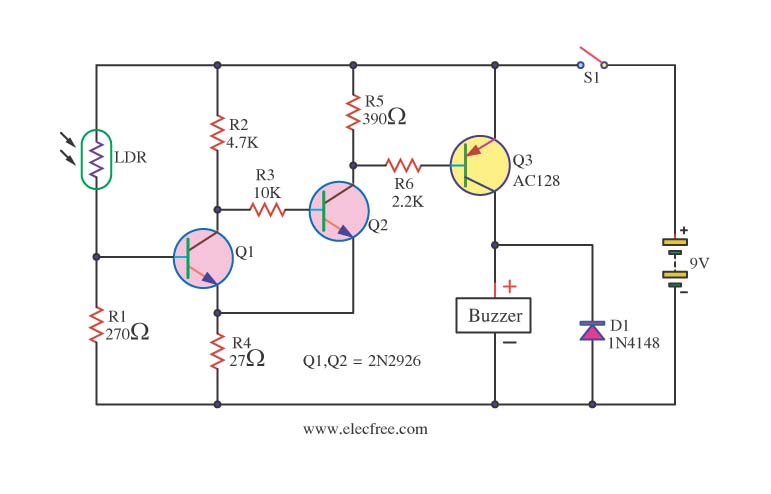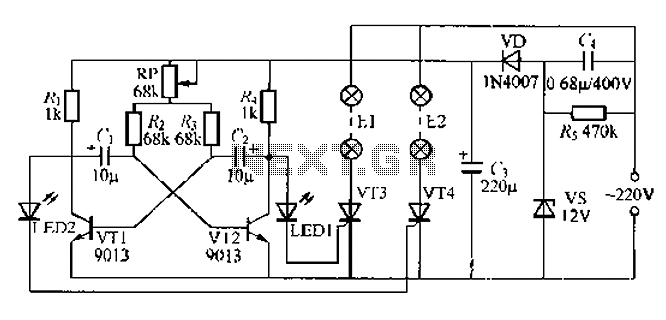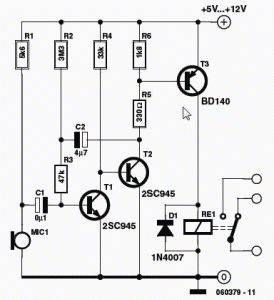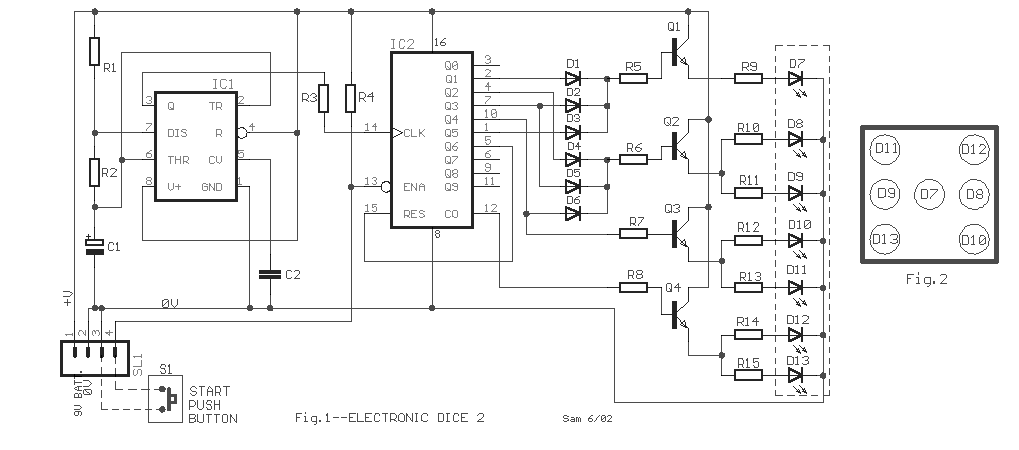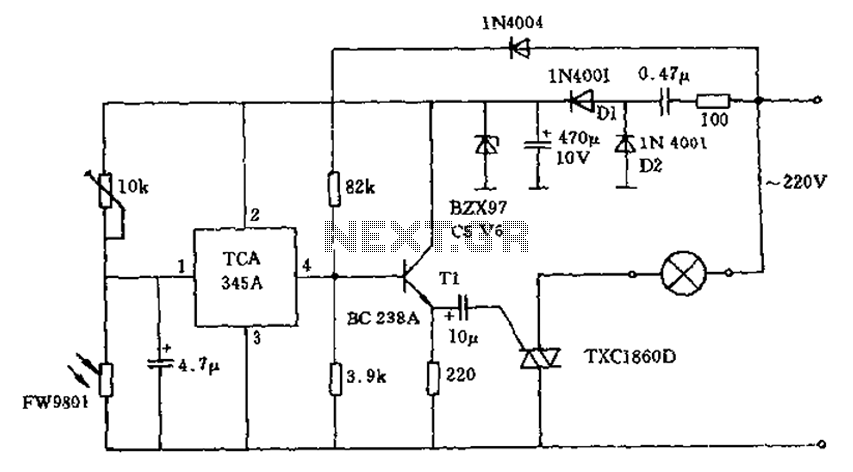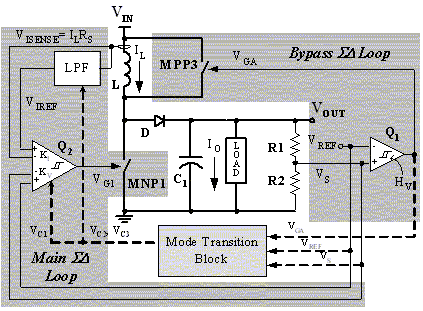
Simple Light Sensor Circuit Features High Dynamic Range
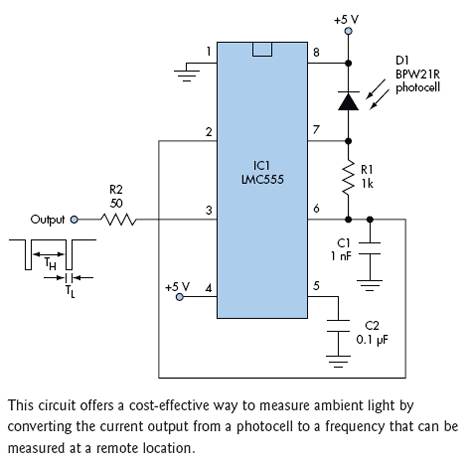
Ambient light is increasingly being utilized as an energy source. To assist designers in developing such systems, this circuit effectively measures ambient light intensity across four decades of measurement. The design is cost-effective, and with the sensor housed in a waterproof glass enclosure, it can be deployed in various weather conditions for continuous monitoring. The application employs a BPW21R photocell (from Vishay) to generate a photocurrent that is proportional to the ambient light intensity. A photovoltage measurement technique would not provide the high dynamic range required. The LMC555 CMOS timer converts the photocurrent from the BPW21R into a transistor-transistor-level (TTL) frequency source, operating between 10 Hz and 100 kHz. While other equivalent timer ICs may be used, it is crucial to ensure component quality to achieve a high dynamic range with accurate measurements. Capacitor C1 should be of the NPO/COG or X7R type, as these types have the lowest temperature coefficients, minimizing frequency drift with temperature. C2 functions as a filter capacitor for the comparator voltage references. C1 and resistor R1 serve as timing elements. The charging time is influenced by the photocurrent from the BPW21R and the value of C1, while the discharge time for C1 depends on its capacitance and the resistance of R1. Both charging and discharge times impact the output frequency, making it essential to select R1 to maintain a low discharge time. In this configuration, R1 is set to 1 kΩ and C1 to 1 nF, resulting in a discharge time of 1 µs. The dark current of the photocell is approximately 2 nA, with a maximum output of about 60 µA at saturation. The cell's linear sensitivity is 9 nA/lx or 9 µA/k lx, providing a high dynamic range that allows operation from 10 nA to 50 µA. The high-level pulse width (TH) is inversely related to light intensity, enabling precise measurements. The low-level pulse width (TL) remains constant and is minimally affected by photocurrent unless R1 exceeds 100 kΩ. R1's value can be tailored to the application and the frequency-measuring device's detection capability. As mentioned, an R1 value of 1 kΩ is optimal for fast measurement devices, while for slower devices, such as microcontrollers, R1 may be increased to 100 kΩ. Raising R1 reduces circuit linearity at high photocell currents, as TL approaches TH. However, if only TH is utilized for measurement, R1 can be set to 100 kΩ without compromising accuracy. Exceeding 100 kΩ results in increased voltage drop across the resistance, diminishing voltage across the photocell and causing nonlinear operation, which is undesirable. Therefore, the recommended range for R1 is between 1 kΩ and 100 kΩ. Resistor R2 is 50Ω, suitable for driving the output signal over several hundred meters of RG58 coaxial cable to a remote measurement location. A significant advantage of this circuit is its ability to operate with a power source ranging from 5 V to 12 V without adversely affecting performance. Additionally, the circuit's low current consumption allows it to function efficiently on a standard 9-V battery.
The circuit is designed to provide a reliable and accurate measurement of ambient light intensity, making it suitable for various applications in energy harvesting and environmental monitoring. The choice of the BPW21R photocell ensures a high sensitivity and dynamic range, essential for applications that require precise light measurements. The use of the LMC555 timer in the configuration allows for flexible frequency output, which can be easily interfaced with microcontrollers or other digital devices for further processing or data logging. The careful selection of capacitors and resistors is crucial to maintain the integrity of the measurements, particularly in varying environmental conditions. The waterproof enclosure provides additional durability, allowing for outdoor deployment without the risk of damage from moisture or other environmental factors. Overall, this circuit represents a robust solution for ambient light measurement, capable of functioning effectively across a wide range of conditions and applications.Ambient light is increasingly being used as a source of energy. To help designers of such systems, this circuit accurately measures ambient light intensity over four decades of measurement. The design is highly cost effective and, with the sensor mounted in a waterproof glass enclosure, can be deployed in the field for continuous monitoring in all
weather conditions. The sensor in this application, a BPW21R photocell (from Vishay), is used to generate photocurrent proportional to the ambient light intensity ( see the figure ). A photovoltage measurement technique would not offer the high dynamic range desired. The LMC555 CMOS timer converts the photocurrent from the BPW21R into a transistor-transistor-level (TTL) frequency source (10 Hz to 100 kHz).
Any other equivalent timer IC can also be used, but component quality is very important in order to get high dynamic range with accurate measurements. Capacitor C1 should be an NPO/COG or X7R type. NPO/COG capacitors have the lowest temperature coefficient and minimize frequency drift with temperature.
C2 is a filter capacitor for the comparator voltage references. C1 and resistor R1 are timing elements. While charging time depends on the photocurrent from the BPW21R and the value of C1, the discharge time for C1 depends on its capacitance and the resistance of R1. Since both charging time and discharge time contribute to the output`s frequency, it`s important to select R1 to keep the discharge time as low as possible.
In this case, R1 is 1 k © and C1 is 1 nF, making the discharge time 1 µs. The photocell`s dark current is about 2 nA and its maximum output is about 60 µA at saturation level. The cell`s linear sensitivity is 9 nA/lx or 9 µA/klx. This high dynamic range allows the photocell to operate from 10 nA to 50 µA easily. The high-level pulse width (TH) is inversely proportional to the light intensity and can be used for very accurate measurements.
The low-level pulse width (TL) remains constant and isn`t significantly affected by the photocurrent unless R1 is greater than 100 k ©. R1`s value can be selected according to the application and the detection capability of the frequency-measuring device.
As noted earlier, an R1 of 1 k © is ideal for a fast measurement device. For slow measurement devices, like a microcontroller, R1 can be as high as 100 k ©. Increasing the value of R1 reduces the circuit`s linearity at high photocell currents, because TL becomes comparable to TH. However, if the measurement technique uses only TH, R1 can be as high as 100 k © without affecting measurement accuracy.
If R1 is larger than 100 k ©, the voltage drop increases across the resistance and the voltage decreases across the photocell. This causes the photocell to operate in a nonlinear region, which is undesirable. Therefore, the best range for R1 is from 1 k © to 100 k ©. Resistor R2 is 50 ©, which is suitable for driving the output signal over several hundred meters of RG58 coaxial cable to a remote measurement room.
An important advantage to this circuit is that the power source can range from 5 V to 12 V without seriously affecting its operation. That and the circuit`s very low current draw allow the design to operate off a standard 9-V battery. 🔗 External reference
The circuit is designed to provide a reliable and accurate measurement of ambient light intensity, making it suitable for various applications in energy harvesting and environmental monitoring. The choice of the BPW21R photocell ensures a high sensitivity and dynamic range, essential for applications that require precise light measurements. The use of the LMC555 timer in the configuration allows for flexible frequency output, which can be easily interfaced with microcontrollers or other digital devices for further processing or data logging. The careful selection of capacitors and resistors is crucial to maintain the integrity of the measurements, particularly in varying environmental conditions. The waterproof enclosure provides additional durability, allowing for outdoor deployment without the risk of damage from moisture or other environmental factors. Overall, this circuit represents a robust solution for ambient light measurement, capable of functioning effectively across a wide range of conditions and applications.Ambient light is increasingly being used as a source of energy. To help designers of such systems, this circuit accurately measures ambient light intensity over four decades of measurement. The design is highly cost effective and, with the sensor mounted in a waterproof glass enclosure, can be deployed in the field for continuous monitoring in all
weather conditions. The sensor in this application, a BPW21R photocell (from Vishay), is used to generate photocurrent proportional to the ambient light intensity ( see the figure ). A photovoltage measurement technique would not offer the high dynamic range desired. The LMC555 CMOS timer converts the photocurrent from the BPW21R into a transistor-transistor-level (TTL) frequency source (10 Hz to 100 kHz).
Any other equivalent timer IC can also be used, but component quality is very important in order to get high dynamic range with accurate measurements. Capacitor C1 should be an NPO/COG or X7R type. NPO/COG capacitors have the lowest temperature coefficient and minimize frequency drift with temperature.
C2 is a filter capacitor for the comparator voltage references. C1 and resistor R1 are timing elements. While charging time depends on the photocurrent from the BPW21R and the value of C1, the discharge time for C1 depends on its capacitance and the resistance of R1. Since both charging time and discharge time contribute to the output`s frequency, it`s important to select R1 to keep the discharge time as low as possible.
In this case, R1 is 1 k © and C1 is 1 nF, making the discharge time 1 µs. The photocell`s dark current is about 2 nA and its maximum output is about 60 µA at saturation level. The cell`s linear sensitivity is 9 nA/lx or 9 µA/klx. This high dynamic range allows the photocell to operate from 10 nA to 50 µA easily. The high-level pulse width (TH) is inversely proportional to the light intensity and can be used for very accurate measurements.
The low-level pulse width (TL) remains constant and isn`t significantly affected by the photocurrent unless R1 is greater than 100 k ©. R1`s value can be selected according to the application and the detection capability of the frequency-measuring device.
As noted earlier, an R1 of 1 k © is ideal for a fast measurement device. For slow measurement devices, like a microcontroller, R1 can be as high as 100 k ©. Increasing the value of R1 reduces the circuit`s linearity at high photocell currents, because TL becomes comparable to TH. However, if the measurement technique uses only TH, R1 can be as high as 100 k © without affecting measurement accuracy.
If R1 is larger than 100 k ©, the voltage drop increases across the resistance and the voltage decreases across the photocell. This causes the photocell to operate in a nonlinear region, which is undesirable. Therefore, the best range for R1 is from 1 k © to 100 k ©. Resistor R2 is 50 ©, which is suitable for driving the output signal over several hundred meters of RG58 coaxial cable to a remote measurement room.
An important advantage to this circuit is that the power source can range from 5 V to 12 V without seriously affecting its operation. That and the circuit`s very low current draw allow the design to operate off a standard 9-V battery. 🔗 External reference
